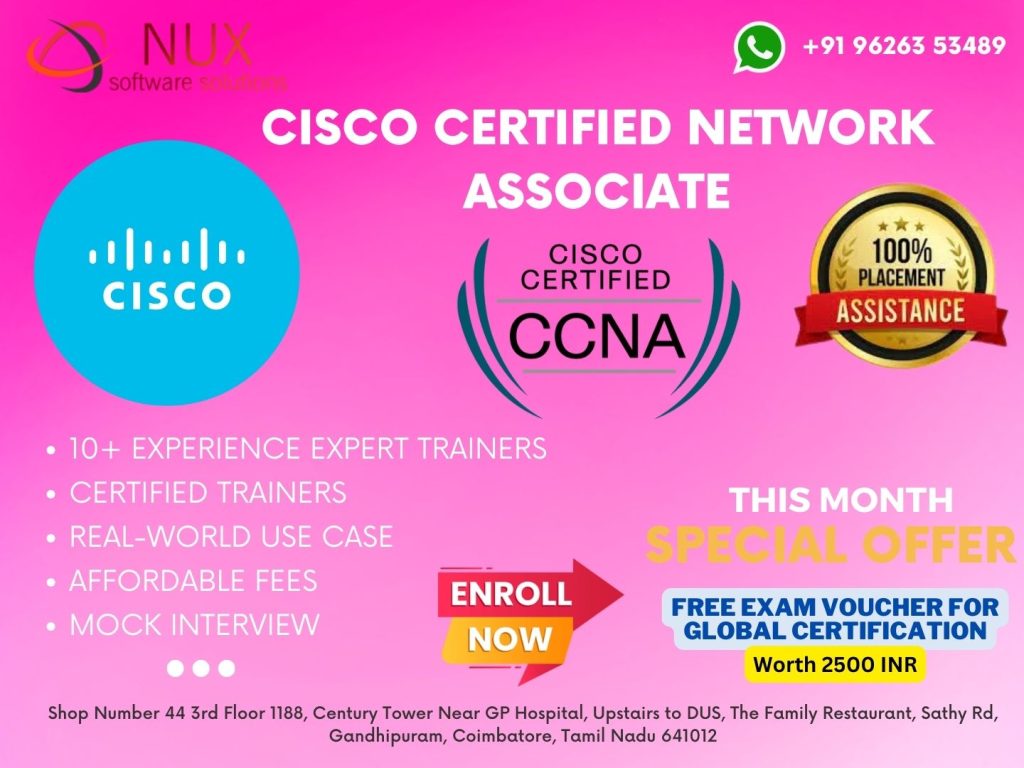Cisco Certified Network Associate (CCNA) Course

Cisco Certified Network Associate (CCNA) Training in Coimbatore
Course Overview
The Cisco Certified Network Associate (CCNA) certification is a globally recognized entry-level certification that lays the foundation for a successful career in networking. It validates your ability to install, configure, operate, and troubleshoot medium-size routed and switched networks. As the first step in Cisco’s certification path, CCNA equips you with in-demand IT skills and opens the door to numerous career opportunities in the networking and cybersecurity domain.
At Linux Training Center in Coimbatore, our CCNA training program is designed for both beginners and IT professionals looking to build or advance their networking skills. The training is aligned with the latest Cisco CCNA 200-301 exam syllabus and provides in-depth practical experience along with theoretical knowledge.
This course is ideal for those aiming to start a career in IT infrastructure, system support, or networking and who want a strong technical foundation with global recognition.
What You Will Learn
Our CCNA training includes a mix of theoretical instruction, hands-on lab sessions, and real-world case studies. Students will gain practical knowledge in:
-
Network Fundamentals: IP addressing, IPv4/IPv6, subnetting, OSI model
-
Routing and Switching: VLANs, inter-VLAN routing, static and dynamic routing, OSPF
-
LAN/WAN Technologies: Configuring routers and switches, WAN connectivity, DHCP
-
Network Access: Ethernet concepts, switch operations, port security
-
IP Connectivity: Routing protocols, route summarization, troubleshooting
-
IP Services: NAT, NTP, DNS, SNMP, QoS
-
Security Fundamentals: Access Control Lists (ACLs), security best practices
-
Automation and Programmability: Basic network automation using Python and APIs
Students will gain access to Cisco Packet Tracer and real hardware labs for hands-on configuration experience.
Who Should Enroll?
-
Beginners aspiring for a career in networking or cybersecurity
-
IT graduates and diploma holders seeking industry-relevant skills
-
System support engineers and help desk technicians
-
Network administrators looking to upgrade their certifications
-
Anyone preparing for more advanced Cisco certifications like CCNP
No prior networking knowledge is required—our training begins from the basics.
Why Choose Our CCNA Course in Coimbatore?
-
Instructor-led training by Cisco-certified professionals
-
Hands-on labs with real routers, switches, and simulation tools
-
Regular practice tests and exam preparation support
-
Flexible batches: weekday, weekend, and online classes
-
Updated content aligned with the Cisco CCNA 200-301 syllabus
-
Affordable pricing and installment options available
Our course also emphasizes real-time troubleshooting and prepares students to face interviews with confidence.
Career Opportunities After CCNA
Earning the CCNA certification enhances your job prospects across various IT roles such as:
-
Network Support Engineer
-
System Administrator
-
Help Desk Technician
-
Network Administrator
-
IT Support Associate
-
Junior Network Engineer
The CCNA also acts as a stepping stone to advanced certifications like CCNP, CCIE, and Cisco Security Certifications, paving the way to higher-paying positions and specialized roles.
Why Linux Training Center, Coimbatore?
At Linux Training Center, we focus on delivering outcome-driven, practical education. Our CCNA training is not just about passing the exam—it’s about building core networking skills that you can apply confidently in real-world environments. With certified instructors, excellent lab infrastructure, and full student support, we make your journey toward becoming a certified network professional seamless and rewarding.
Cisco Certified Network Associate (CCNA) Syllabus
Module 1
Chapter 1
Compare and contrast OSI and TCP/IP models
Chapter 2
Compare and contrast TCP and UDP protocols
Chapter3
Describe the impact of infrastructure components in an enterprise network, a) Firewalls, b) Access points, c) Wireless controllers
Chapter 4
Describe the effects of cloud resources on enterprise network architecture, a) Traffic path to internal and external cloud services, b) Virtual services, c) Basic virtual network infrastructure
Chapter 5
Compare and contrast collapsed core and three-tier architectures
Chapter 6
Compare and contrast network topologies, a) Star, b) Mesh, c) Hybrid
Chapter 7
Select the appropriate cabling type based on implementation requirements
Chapter 8
Apply troubleshooting methodologies to resolve problems, a) Perform and document fault isolation, b) Resolve or escalate, c) Verify and monitor resolution
Chapter 9
Configure, verify, and troubleshoot IPv4 addressing and subnetting
Chapter 10
Compare and contrast IPv4 address types, a) Unicast, b) Broadcast, c) Multicast
Chapter 11
Describe the need for private IPv4 addressing
Chapter 12
Identify the appropriate IPv6 addressing scheme to satisfy addressing requirements in a LAN/WAN environment
Chapter 13
Configure, verify, and troubleshoot IPv6 addressing
Chapter 14
Configure and verify IPv6 Stateless Address Auto Configuration
Chapter 15
Compare and contrast IPv6 address types, a) Global unicast, b) Unique local, c) Link local, d) Multicast, e) Modified EUI 64, f) Autoconfiguration, g) Anycast
MODULE 2 : LAN Switching Technologies
Chapter 1
Describe and verify switching concepts, a) MAC learning and aging, b) Frame switching, c) Frame flooding, d) MAC address table
Chapter 2
Interpret Ethernet frame format
Chapter 3
Troubleshoot interface and cable issues (collisions, errors, duplex, speed)
Chapter 4
Configure, verify, and troubleshoot VLANs (normal/extended range) spanning multiple switches, a) Access ports (data and voice), b) Default VLAN
Chapter 5
Configure, verify, and troubleshoot interswitch connectivity, a) Trunk ports, b) Add and remove VLANs on a trunk, c) DTP, VTP (v1&v2), and 802.1Q, d) Native VLAN
Chapter 6
Configure, verify, and troubleshoot STP protocols, a) STP mode (PVST+ and RPVST+), b) STP root bridge selection
Chapter 7
Configure, verify and troubleshoot STP related optional features, a) PortFast, b) BPDU guard
Chapter 8
Configure and verify Layer 2 protocols, a) Cisco Discovery Protocol, b) LLDP
Chapter 9
Configure, verify, and troubleshoot (Layer 2/Layer 3) EtherChannel, a) Static, b) PAGP, c) LACP
Chapter 10
Describe the benefits of switch stacking and chassis aggregation
MODULE 3 : Routing Technologies
Chapter 1
Describe the routing concepts, a) Packet handling along the path through a network, b) Forwarding decision based on route lookup, c) Frame rewrite
Chapter 2
Interpret the components of a routing table, a) Prefix, b) Network mask, c) Next hop, d) Routing protocol code, e) Administrative distance, f) Metric, g) Gateway of last resort
Chapter 3
Describe how a routing table is populated by different routing information sources, a) Admin distance
Chapter 4
Configure, verify, and troubleshoot inter-VLAN routing, a) Router on a stick, b) SVI
Chapter 5
Compare and contrast static routing and dynamic routing
Chapter 6
Compare and contrast distance vector and link state routing protocols
Chapter 7
Compare and contrast interior and exterior routing protocols
Chapter 8
Configure, verify, and troubleshoot IPv4 and IPv6 static routing, a) Default route, b) Network route, c) Host route, d) Floating static
Chapter 9
Configure, verify, and troubleshoot single area and multi-area OSPFv2 for IPv4 (excluding authentication, filtering, manual summarization, redistribution, stub, virtual-link, and LSAs)
Chapter 10
Configure, verify, and troubleshoot single area and multi-area OSPFv3 for IPv6 (excluding authentication, filtering, manual summarization, redistribution, stub, virtual-link, and LSAs)
Chapter 11
Configure, verify, and troubleshoot EIGRP for IPv4 (excluding authentication, filtering, manual summarization, redistribution, stub)
Chapter 12
Configure, verify, and troubleshoot EIGRP for IPv6 (excluding authentication, filtering, manual summarization, redistribution, stub)
Chapter 13
Configure, verify, and troubleshoot RIPv2 for IPv4 (excluding authentication, filtering, manual summarization, redistribution)
Chapter 14
Troubleshoot basic Layer 3 end-to-end connectivity issues
MODULE 4 : WAN Technologies
Chapter 1
Configure and verify PPP and MLPPP on WAN interfaces using local authentication
Chapter 2
Configure, verify, and troubleshoot PPPoE client-side interfaces using local authentication
Chapter 3
Configure, verify, and troubleshoot GRE tunnel connectivity
Chapter 4
Describe WAN topology options, a) Point-to-point, b) Hub and spoke, c) Full mesh, d) Single vs dual-homed
Chapter 5
Describe WAN access connectivity options, a) MPLS, b) Metro Ethernet, c) Broadband PPPoE, d) Internet VPN (DMVPN, site-to-site VPN, client VPN)
Chapter 6
Configure and verify single-homed branch connectivity using eBGP IPv4 (limited to peering and route advertisement using Network command only)
Chapter 7
Describe basic QoS concepts, a) Marking, b) Device trust,
c) Prioritization,
[i] Voice
[ii] Video
[iii] Data
d) Shaping, e) Policing, f) Congestion management
MODULE 5 : Infrastructure Services
Chapter 1
Describe DNS lookup operation
Chapter 2
Troubleshoot client connectivity issues involving DNS
Chapter 3
Configure and verify DHCP on a router (excluding static reservations), a) Server, b) Relay, c) Client, d) TFTP, DNS, and gateway options
Chapter 4
Troubleshoot client- and router-based DHCP connectivity issues
Chapter 5
Configure, verify, and troubleshoot basic HSRP, a) Priority, b) Preemption, c) Version
Chapter 6
Configure, verify, and troubleshoot inside source NAT, a) Static, b) Pool, c) PAT
Chapter 7
Configure and verify NTP operating in a client/server mode
MODULE 6 : Infrastructure Security
Chapter 1
Configure, verify, and troubleshoot port security, a) Static, b) Dynamic, c) Sticky, d) Max MAC addresses, e) Violation actions, f) Err-disable recovery
Chapter 2
Describe common access layer threat mitigation techniques, a) 802.1x, b) DHCP snooping, c) Nondefault native VLAN
Chapter 3
Configure, verify, and troubleshoot IPv4 and IPv6 access list for traffic filtering, a) Standard, b) Extended, c) Named
Chapter 4
Verify ACLs using the APIC-EM Path Trace ACL analysis tool
Chapter 5
Configure, verify, and troubleshoot basic device hardening, a) Local authentication, b) Secure password,
c) Access to device
[i] Source address, [ii] Telnet/SSH, d) Login banner
Chapter 6
Describe device security using AAA with TACACS+ and RADIUS
MODULE 7 : Infrastructure Management
Chapter 1
Configure and verify device-monitoring protocols, a) SNMPv2, b) SNMPv3, c) Syslog
Chapter 2
Troubleshoot network connectivity issues using ICMP echo-based IP SLA
Chapter 3
Configure and verify device management, a) Backup and restore device configuration, b) Using Cisco Discovery Protocol or LLDP for device discovery, c) Licensing, d) Logging, e) Timezone, f) Loopback
Chapter 4
Configure and verify initial device configuration
Chapter 5
Perform device maintenance, a) Cisco IOS upgrades and recovery (SCP, FTP, TFTP, and MD5 verify), b) Password recovery and configuration register, c) File system management
Chapter 6
Use Cisco IOS tools to troubleshoot and resolve problems, a) Ping and traceroute with extended option, b) Terminal monitor, c) Log events, d) Local SPAN
Chapter 7
Describe network programmability in enterprise network architecture, a) Function of a controller, b) Separation of control plane and data plane, c) Northbound and southbound APIs



